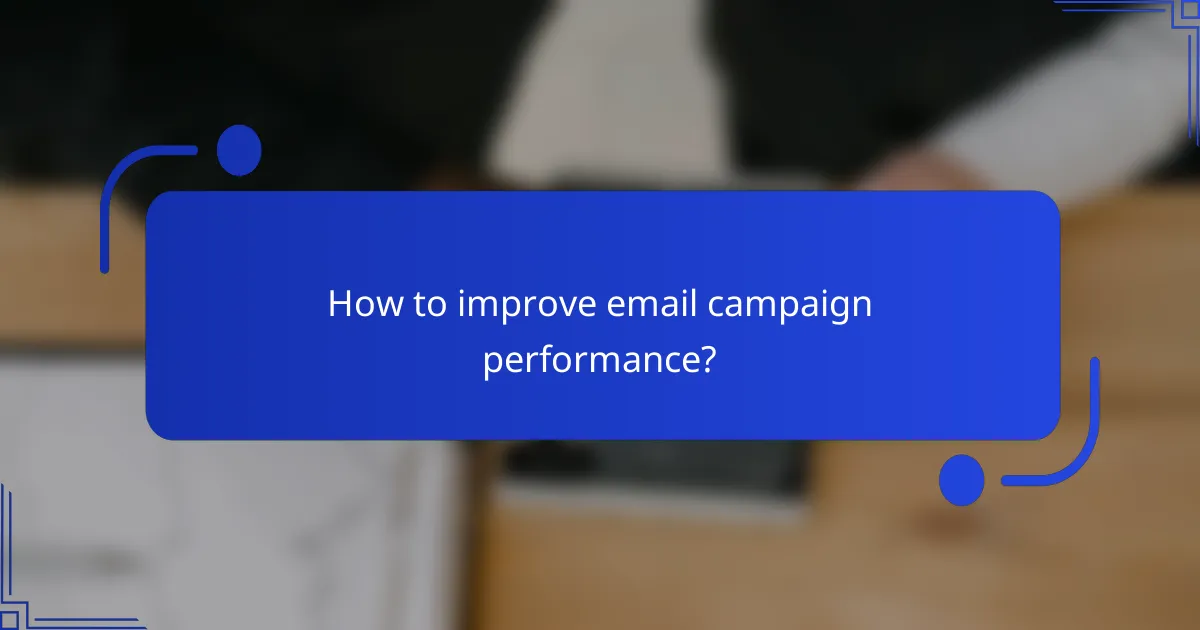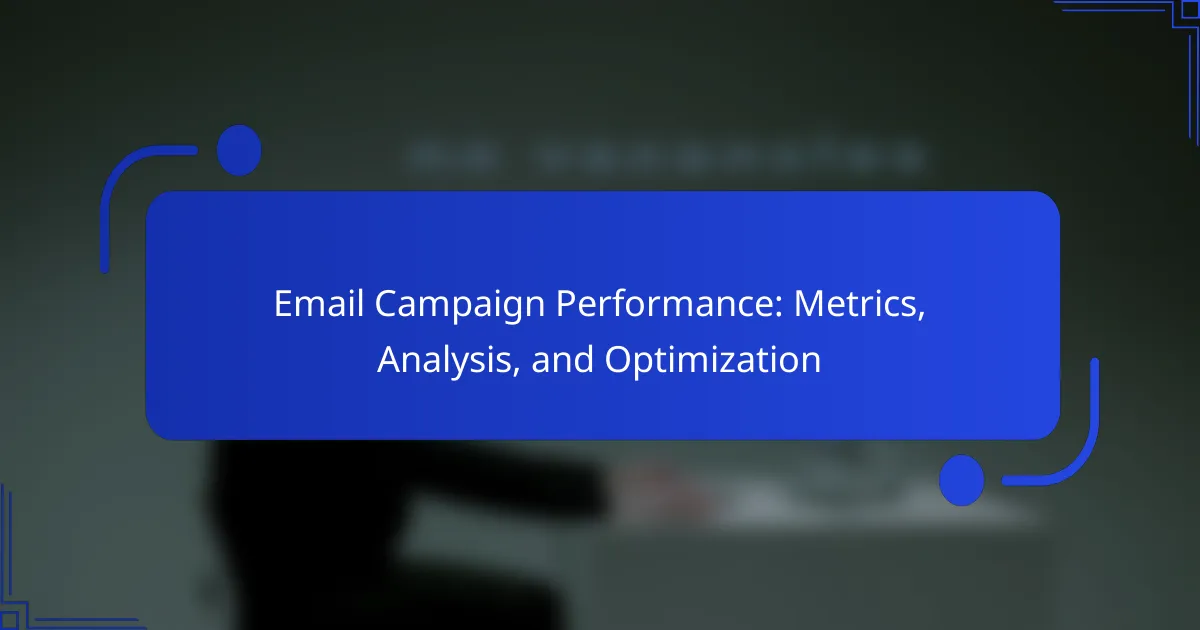Email campaigns are a powerful tool for driving engagement and conversions, but their success hinges on careful optimization and analysis. By focusing on key metrics such as open rates, click-through rates, and conversion rates, marketers can gain valuable insights into audience behavior and identify opportunities for improvement. Implementing strategies like A/B testing and audience segmentation can further enhance campaign performance, leading to more effective communication and higher returns on investment.

How to improve email campaign performance?
Improving email campaign performance involves optimizing various elements to enhance engagement and conversions. Focus on refining subject lines, audience segmentation, send times, A/B testing, and calls-to-action to achieve better results.
Optimize subject lines
Subject lines are crucial for capturing attention and encouraging opens. Aim for concise, clear, and compelling phrases that convey the email’s value. Using personalization, urgency, or curiosity can significantly boost open rates.
Consider testing different styles and lengths to see what resonates best with your audience. A/B testing can help determine which subject lines perform better, allowing you to refine your approach over time.
Segment your audience
Segmentation involves dividing your email list into smaller groups based on specific criteria such as demographics, behavior, or purchase history. This targeted approach allows you to tailor your messaging to meet the unique needs of each segment.
Effective segmentation can lead to higher engagement rates, as recipients receive content that is more relevant to them. Aim for segments that are manageable yet distinct enough to warrant different messaging strategies.
Test send times
Send times can significantly impact email performance. Testing different days and times can help identify when your audience is most likely to engage with your emails. Generally, mid-week mornings or early afternoons tend to yield better results.
Utilize analytics to track open and click rates based on send times. Adjust your strategy accordingly to optimize engagement and ensure your emails reach recipients when they are most receptive.
Utilize A/B testing
A/B testing allows you to compare two versions of an email to determine which performs better. This method can be applied to various elements, including subject lines, content, images, and calls-to-action.
Conduct tests with a small percentage of your audience before rolling out the winning version to the entire list. This approach minimizes risk and maximizes the potential for improved performance based on data-driven insights.
Enhance call-to-action
The call-to-action (CTA) is a critical component of your email that directs recipients on what to do next. Ensure your CTA is clear, compelling, and visually distinct to encourage clicks. Use action-oriented language that creates a sense of urgency.
Consider placing multiple CTAs throughout the email for longer content, but ensure they are relevant to the surrounding text. Regularly review and optimize CTAs based on performance metrics to drive better results.

What metrics should you track for email campaigns?
To effectively measure the success of your email campaigns, focus on key metrics such as open rate, click-through rate, conversion rate, unsubscribe rate, and bounce rate. These metrics provide insights into how recipients engage with your emails and help identify areas for improvement.
Open rate
The open rate indicates the percentage of recipients who opened your email. It is calculated by dividing the number of unique opens by the number of delivered emails, then multiplying by 100. A typical open rate can range from 15% to 25%, depending on the industry.
To improve your open rate, consider optimizing your subject lines and sending times. Personalization and segmentation can also enhance engagement, making your emails more relevant to specific audiences.
Click-through rate
The click-through rate (CTR) measures the percentage of recipients who clicked on one or more links in your email. This is calculated by dividing the number of clicks by the number of delivered emails and multiplying by 100. A good CTR generally falls between 2% and 5% across various sectors.
To boost your CTR, ensure that your email content is compelling and includes clear calls to action. A/B testing different link placements and styles can also help identify what resonates best with your audience.
Conversion rate
The conversion rate reflects the percentage of recipients who completed a desired action after clicking through your email, such as making a purchase or signing up for a webinar. It is calculated by dividing the number of conversions by the total number of clicks, then multiplying by 100. Conversion rates can vary widely, often ranging from 1% to 10%.
To enhance your conversion rate, ensure that your landing pages are optimized for user experience and aligned with your email content. Clear messaging and easy navigation are crucial for guiding recipients toward completing the desired action.
Unsubscribe rate
The unsubscribe rate shows the percentage of recipients who opted out of your email list after receiving a campaign. This is calculated by dividing the number of unsubscribes by the total number of delivered emails and multiplying by 100. A typical unsubscribe rate is usually below 1%.
To minimize your unsubscribe rate, focus on delivering valuable content that meets your audience’s expectations. Regularly cleaning your email list and allowing recipients to adjust their preferences can also help maintain engagement.
Bounce rate
The bounce rate indicates the percentage of emails that could not be delivered to recipients’ inboxes. There are two types of bounces: soft bounces (temporary issues) and hard bounces (permanent issues). A bounce rate of less than 2% is generally considered acceptable.
To reduce bounce rates, regularly verify your email list to remove invalid addresses and ensure compliance with email regulations. Monitoring bounce rates can help you maintain a healthy sender reputation and improve overall deliverability.

How to analyze email campaign data?
To analyze email campaign data effectively, focus on key metrics that reveal how recipients interact with your emails. This involves examining engagement rates, conversion metrics, and overall performance against industry benchmarks.
Use Google Analytics
Google Analytics is a powerful tool for tracking email campaign performance. By integrating your email marketing platform with Google Analytics, you can monitor user behavior on your website after they click through from your emails.
Look for metrics such as session duration, pages per session, and bounce rates to understand how engaged users are once they arrive at your site. This data helps you assess the effectiveness of your email content in driving meaningful traffic.
Implement UTM parameters
UTM parameters are tags added to your email links that help track the source of traffic in Google Analytics. By using UTM parameters, you can identify which emails are generating the most visits and conversions.
For example, you might use parameters like `utm_source=email`, `utm_medium=newsletter`, and `utm_campaign=spring_sale`. This allows for granular analysis of each campaign’s performance, making it easier to optimize future efforts.
Review engagement trends
Engagement trends provide insights into how your audience interacts with your emails over time. Monitor open rates, click-through rates, and unsubscribe rates to identify patterns and shifts in audience behavior.
Consider segmenting your data by demographics or engagement levels to uncover specific trends. For instance, you might find that younger audiences prefer shorter, visually appealing emails, while older segments engage more with detailed content.
Compare against benchmarks
Comparing your email campaign metrics against industry benchmarks helps you gauge performance. Look for average open rates, click-through rates, and conversion rates relevant to your sector.
For example, if the average open rate in your industry is around 20-25%, and your campaign is consistently below this range, it may indicate a need for improved subject lines or targeting strategies. Regular benchmarking allows you to set realistic goals and measure progress effectively.

What are the best tools for email campaign optimization?
The best tools for email campaign optimization help marketers improve engagement and conversion rates through data analysis and targeted strategies. These platforms offer features like A/B testing, analytics, and automation to refine email performance effectively.
Mailchimp
Mailchimp is a popular choice for email campaign optimization, known for its user-friendly interface and robust analytics. It provides tools for segmenting audiences, automating campaigns, and performing A/B tests to determine the most effective content and timing.
Consider using Mailchimp’s reporting features to track open rates, click-through rates, and conversion metrics. These insights can guide adjustments to your campaigns, ensuring you focus on what resonates with your audience.
For best results, regularly review your audience segments and tailor your messaging accordingly. Avoid sending generic emails; instead, personalize content based on user behavior and preferences.
HubSpot
HubSpot offers a comprehensive suite for email campaign optimization, integrating seamlessly with its CRM and marketing tools. This platform allows for advanced segmentation, detailed reporting, and workflow automation, making it suitable for businesses looking to enhance their email strategies.
Utilize HubSpot’s analytics dashboard to monitor performance metrics such as engagement rates and ROI. The platform’s ability to track user interactions across various channels can provide a holistic view of your marketing efforts.
To maximize effectiveness, leverage HubSpot’s automation features to nurture leads through personalized email sequences. Ensure you regularly update your contact lists to maintain engagement and avoid sending emails to inactive users.
